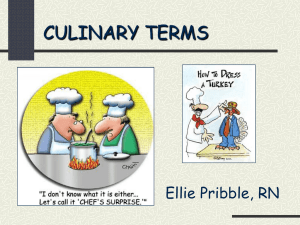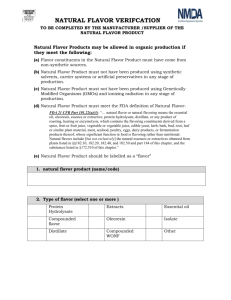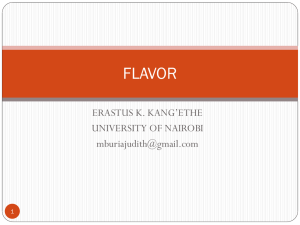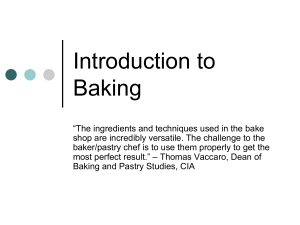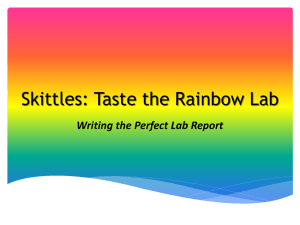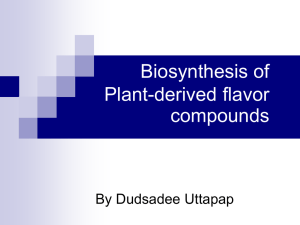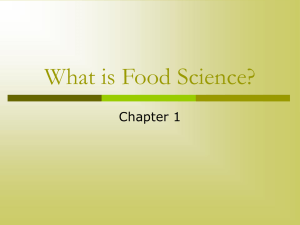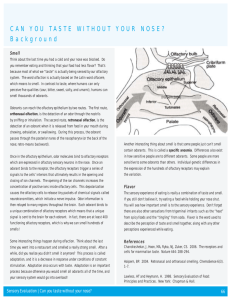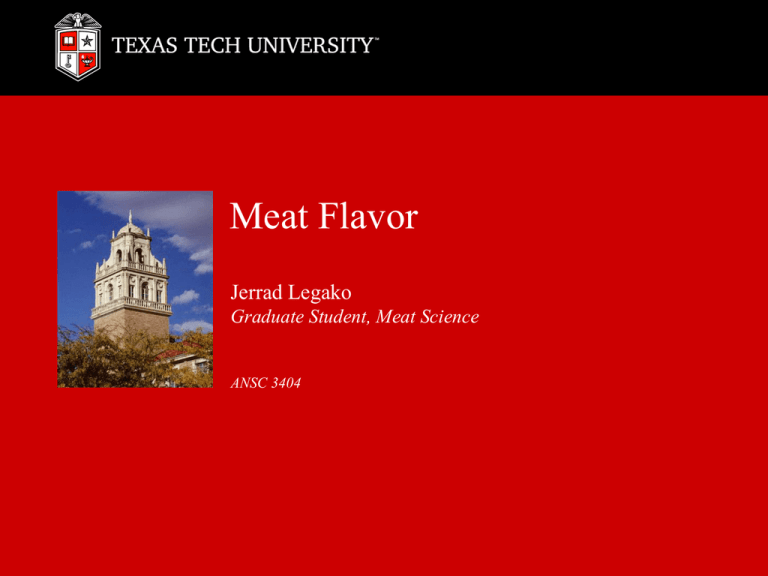
Meat Flavor
Jerrad Legako
Graduate Student, Meat Science
ANSC 3404
IMPORTANCE OF FLAVOR
Consumer perception of meat quality
• After appearance and tenderness flavor is most
important
• Specifically cooked meat flavor
Flavor is a key factor for acceptance
• Understanding flavor is therefore crucial
– Analysis of flavor compounds
(Machiels and Istasse)
MEAT PALATABILITY
Tenderness
Juiciness
Flavor
Flavor often considered the most important when tenderness is
acceptable
Result of volatile compounds produced during cooking
TASTE vs. FLAVOR
• Taste refers to the five basic receptors: sweet,
salty, sour, bitter and umami
• Flavor is the perception of chemical
compounds reacting with receptors in the oral
and nasal cavities (aroma) in combination with
taste
Perception of Flavor (Taste and Aroma)
Aroma
Olfactory
receptors
Detected in nose
Small, volatile, fat
soluble molecules
Anterior
nares
Posterior
nares
Taste
Tongue
Taste receptors
Detected on tongue
and in mouth
Large, water soluble
molecules
(L. J. Farmer)
TASTE
• Salt and sour receptors are well
understood while bitter and
sweet receptors appear to be
more complex.
UMAMI
•Umami [oo-MOM-ee], known as the fifth taste,
is described as meaty and savory or delicious
• derived from umai, the Japanese word for delicious
• Glutamates – the salts of an amino acid - and other small
molecules called nucleotides
•Although umami has been known for quite
awhile, recently umami receptors have been
clearly identified so this is a bona fide fifth taste.
5 TASTES
• Detection of these five tastes has been key to
our survival throughout the ages
• Sweet means energy-giving carbohydrates
• Salt indicates essential minerals for life-sustaining cell
functions and wound healing
• Sour says to “proceed with caution,” since many foods sour
as they deteriorate.
• Umami signifies life-giving protein.
• And bitter warns “spit it out, don’t touch it” because many
natural toxins taste bitter
FLAVOR CHEMISTRY
What is flavor chemistry?
A study of compounds which elicit a
chemosensation or flavor sensation
What produces flavor sensations?
Chemical compounds reacting with
receptors in the oral and nasal cavities
Specifically ingested volatile
compounds
(Christen and Smith)
FLAVOR CHEMISTRY
Over 200 flavor compounds associated with
cooked beef
Sulferous and carbonyl compounds are predominate
contributors
Maillard reaction products
• End products result from sugars and amino groups
Lipid breakdown products
• Higher concentrations may produce undesirable flavors
(Calkins and Hodgen)
MAIN FLAVOR FORMING REACTIONS
Precursors
Aroma compounds, e.g.
Reducing sugars,
nucleotides,
Maillard reaction
amino acids,
peptides
CH3
S
S
SH
O
Thiamine
(L.J. Farmer)
O
O
O
S S
O
Thermal oxidation
HEAT
CH3
NH
S S
SH
Thermal degradation
O
Lipids,
fatty acids
N
CHO
O
CHO
O
O
O
CHO
MAILLARD REACTION
• Reducing sugar and free amino acid
• Results in the production of H2O,
• Therefore reaction does not occur with moist heat cookery
reducing sugar + amine = brown pigments + flavors
Flavor Compounds Formation by Maillard
Reaction
Reducing Sugars and -amino acids
N-glycosylamine or N-fructosylamine
1-Amino-1-deoxy-2-ketose (Amadori intermediate) or
2-Amino-2-deoxy-1-aldose (Heynes intermediate)
+
H2 S
NH3
Furans
Thiophenes
Pyrroles
Reductones and Dehydroreductones
Retroaldol Reaction
Hydroxyacetone
Hydroxyacetylaldehyde
Acetoin
Acetylaldehyde
Glyoxal
Pyruvaldehyde
Glycerolaldehyde
Heterocyclizaion
Pyrazines
Pyridines
Oxazoles
Thiazoles
Pyrroles
+ Amino Strecker
Acids degradation
Strecker Aldehydes +
CO2 + -aminoketone
(Methional, NH3, H2S)
FLAVOR COMPOUND ANALYSIS
Volatile compounds must be extracted
• Head space solid phase microextraction (HS-SPME)
Separation of compounds may be done via gas
chromatography (GC)
Compounds may then be identified and sensory evaluated
• Identified: purified standards and/or mass spectral library
• Sensory evaluation: olfactometry
(Frank and others)
HS-SPME/GC-MS-Olfactory
DISCUSSION
Flavor is important to overall palatability of meat
Flavor compounds may be studied by chemical and sensory
evaluation
Maillard reaction and lipid breakdown products are dependent
on the type and condition of meat
FACTORS AFFECTING MEAT FLAVOR
Species
Red meat species and poultry
Breed
Bos indicus vs Bos taurus?
Sex
Androstenone, skatole
Diet
Grain-fed vs. Grass-fed
Age
Young lamb vs. mutton
Packaging
MAP, over-wrap, vacuum
FACTORS AFFECTING MEAT
FLAVOR
Fat
Amount and type
Muscle
Location effect
Aging
Dry vs. wet
Enhancement
Brine solution containing salt
Cooking method
Dry vs. moist heat
Degree of doneness
Top 20 Beef Flavor Pairings in
Newsstand Beef Recipes
• Onion 60%
• Garlic 55%
• Tomato* 32%
• Beef Broth/Stock/Bouillon* 25%
• Wine (mainly red)* 20%
• Cheese (mainly Parmesan, Cheddar, Blue)* 19%
• Sugar 18%
• Cream 18%
• Bell Pepper 16% • Vinegar 16%
• Thyme 15%
• Parsley 14%
• Cayenne 13%
• Mushroom* 13%
• Soy Sauce* 11% • Cumin 11%
• Mustard 10%
• Ginger 10%
*indicates umami-rich ingredients
• Bay Leaves 10% • Oregano 10%
Beef and the Restaurant Scene
Today’s Menu Special: Beef Flavored with…
Onion
Cheese*
Mushroom*
Wine*
Garlic
Pepper/Peppercorns
Truffles*
Peppers/Green Peppers
Shallots
Bacon*
Barbecue Sauce*
Horseradish
Béarnaise
Mustard
*indicates umami-rich ingredients
http://www.beefandvealculinary.com/beefflavorp
airings.aspx



